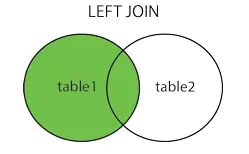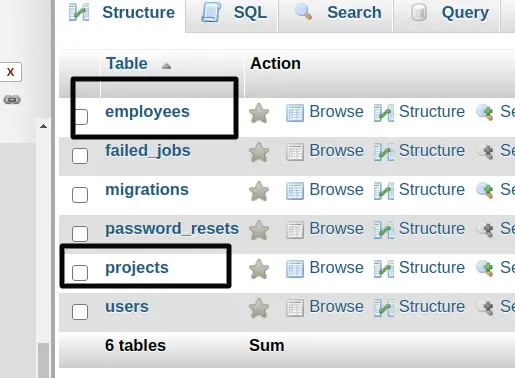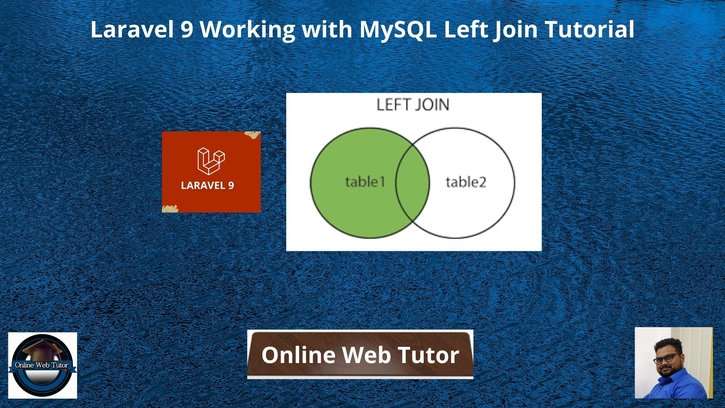When we work with MySQL Queries, then definitely for some relational data we need to work with Joins. Inside this article we will see the concept of Laravel 9 Working with MySQL Left Join.
Joins in Laravel 9 is the connection between one and more tables to get data. In MySQL we have Inner join, Left join, Right join etc.
We will see the concept of Left Join in this Laravel 9 article. This article will give you the detailed concept of about implementation of left Join in laravel 9.
For this tutorial we will consider a employees table and a projects table.
Learn More –
- Laravel 9 Working with MySQL Inner Join Tutorial
- Laravel 9 YajraBox Server Side Datatable Tutorial
- Migrate Specific Migration File in Laravel 9 Tutorial
Let’s get started.
Types of Joins
In Laravel 9 application, as per the documentation we have following types of joins available –
- Inner Join
- Left Join
- Right Join
- Cross Join
What is Left Join?
Left Join – This also works same the matched condition between two or more than two tables. But in this case we also get the rows of left table which doesn’t match with the condition with the right hand sided table. Means we get all rows of left table including values of matched with right table.

How can we use inside an application and get relational data we will see by making an application. Let’s create an application in which we use Left Join.
Laravel Installation
Open terminal and run this command to create a laravel project.
composer create-project laravel/laravel myblogIt will create a project folder with name myblog inside your local system.
To start the development server of laravel –
php artisan serveURL: http://127.0.0.1:8000
Assuming laravel already installed inside your system.
Create Database & Connect
To create a database, either we can create via Manual tool of PhpMyadmin or by means of a mysql command.
CREATE DATABASE laravel_app;
To connect database with application, Open .env file from application root. Search for DB_ and update your details.
DB_CONNECTION=mysql DB_HOST=127.0.0.1 DB_PORT=3306 DB_DATABASE=laravel_app DB_USERNAME=root DB_PASSWORD=root
Create Migrations & Model
Next,
Let’s create migrations and models for Employees and Projects table.
Open project into terminal and run this artisan command.
$ php artisan make:model Employee -mIt will create two files –
- Model file Employee.php inside /app/Models folder.
- Migration file 2022_05_15_062204_create_employees_table.php inside /database/migrations folder.
$ php artisan make:migration create_projects_tableIt will create a migration file 2022_05_15_062234_create_projects_table.php inside /database/migrations folder.
Open xxx_create_employees_table.php and write this following code into it.
<?php
use Illuminate\Database\Migrations\Migration;
use Illuminate\Database\Schema\Blueprint;
use Illuminate\Support\Facades\Schema;
return new class extends Migration
{
/**
* Run the migrations.
*
* @return void
*/
public function up()
{
Schema::create('employees', function (Blueprint $table) {
$table->id();
$table->string("name", 50);
$table->string("email", 50);
$table->string("phone_no", 20);
});
}
/**
* Reverse the migrations.
*
* @return void
*/
public function down()
{
Schema::dropIfExists('employees');
}
};
Open xxx_create_projects_table.php and write this following code into it.
<?php
use Illuminate\Database\Migrations\Migration;
use Illuminate\Database\Schema\Blueprint;
use Illuminate\Support\Facades\Schema;
return new class extends Migration
{
/**
* Run the migrations.
*
* @return void
*/
public function up()
{
Schema::create('projects', function (Blueprint $table) {
$table->id();
$table->integer('employee_id')->unsigned();
$table->string("project_name", 100);
$table->foreign('employee_id')
->references('id')->on('employees')
->onDelete('cascade');
});
}
/**
* Reverse the migrations.
*
* @return void
*/
public function down()
{
Schema::dropIfExists('projects');
}
};
Migrate Migrations
Back to terminal and run this command to migrate all migrations.
$ php artisan migrateThis command will migrate all.

Insert Test Data For Tables
Here,
We have some mysql queries which will insert test data to employees and projects table.
Copy command and run into SQL tab of mysql database.
-- -- Dumping data for table `employees` -- INSERT INTO `employees` (`id`, `name`, `email`, `phone_no`) VALUES (1, 'Sanjay Kumar', 'sanjay@gmail.com', '8527419630'), (2, 'Vijay Kumar', 'vijay@gmail.com', '9632587410'), (3, 'Ashish Kumar', 'ashish@gmail.com', '7896541356'), (4, 'Dhananjay Kumar', 'dhananjay@gmail.com', '7896585296'), (5, 'Pradeep Kumar', 'pradeep@gmail.com', '7896556565');
-- -- Dumping data for table `projects` -- INSERT INTO `projects` (`id`, `employee_id`, `project_name`) VALUES (1, 1, 'Project 4'), (2, 2, 'Project 7'), (3, 3, 'Project 50');
Create Controller
Open project into terminal and run this command.
$ php artisan make:controller SiteControllerIt will create SiteController.php file inside /app/Http/Controllers folder.
Open SiteController.php and write this code into it.
<?php
namespace App\Http\Controllers;
use Illuminate\Http\Request;
use App\Models\Employee;
class SiteController extends Controller
{
public function getData()
{
$data = Employee::leftJoin("projects", function ($join) {
$join->on("projects.employee_id", "=", "employees.id");
})->get();
echo "<pre>";
print_r($data);
}
}
Left Join Logic
$data = Employee::leftJoin("projects", function ($join) {
$join->on("projects.employee_id", "=", "employees.id");
})->get();OR
$data = Employee::leftJoin("projects", "projects.employee_id", "=", "employees.id")->get();Generated Query
To get last executed query –
$query = Employee::leftJoin("projects", function ($join) {
$join->on("projects.employee_id", "=", "employees.id");
})->toSql();Query will be –
select * from `employees` left join `projects` on `projects`.`employee_id` = `employees`.`id`Add Route
Open web.php file from /routes folder.
//...
use App\Http\Controllers\SiteController;
Route::get("left-join", [SiteController::class, "getData"]);
//...
Application Testing
Run this command into project terminal to start development server,
php artisan serveURL – http://127.0.0.1:8000/left-join
You will get your data set at output screen.
Complete Data of Left table + Matched data with Right Table
Advanced Cases in Left Join
Assuming these cases, you can take a hint from these.
Example 1: Laravel Eloquent leftJoin() with 2 Tables
$users = User::leftJoin('posts', 'users.id', '=', 'posts.user_id') ->get(['users.*', 'posts.descrption']);Generated Query
select `users`.*, `posts`.`descrption` from `users` left join `posts` on `users`.`id` = `posts`.`user_id`Example 2: Laravel Eloquent leftJoin() with 3 Tables
$users = User::leftJoin('posts', 'posts.user_id', '=', 'users.id') ->leftJoin('comments', 'comments.post_id', '=', 'posts.id') ->get(['users.*', 'posts.descrption']);Generated Query
select `users`.*, `posts`.`descrption` from `users` left join `posts` on `posts`.`user_id` = `users`.`id` left join `comments` on `comments`.`post_id` = `posts`.`id`Example 3: Laravel Eloquent leftJoin() with Multiple Conditions
$users = User::leftJoin('posts', 'posts.user_id', '=', 'users.id') ->where('users.status', 'active')
->where('posts.status','active')
->get(['users.*', 'posts.descrption']);Generated Query
select `users`.*, `posts`.`descrption` from `users` left join `posts` on `posts`.`user_id` = `users`.`id` where `users`.`status` = active and `posts`.`status` = activeWe hope this article helped you to learn about Laravel 9 Working with MySQL Left Join Tutorial in a very detailed way.
Online Web Tutor invites you to try Skillshike! Learn CakePHP, Laravel, CodeIgniter, Node Js, MySQL, Authentication, RESTful Web Services, etc into a depth level. Master the Coding Skills to Become an Expert in PHP Web Development. So, Search your favourite course and enroll now.
If you liked this article, then please subscribe to our YouTube Channel for PHP & it’s framework, WordPress, Node Js video tutorials. You can also find us on Twitter and Facebook.
